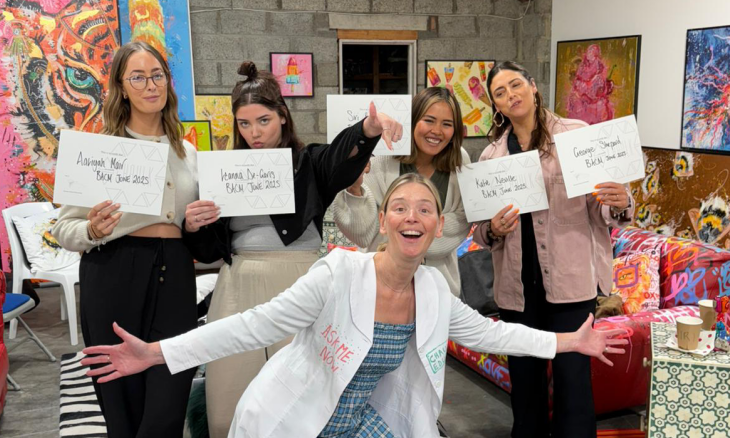In a world where colour education is often shaped by brand loyalty and trend-led techniques, Sarah Spiers is leading a quiet revolution. With over 30 years of experience and as the founder of Chaulk Education, Sarah’s unique and innovative Become a Colour Master Tour is reframing what it means to be a confident, creative colourist in 2025, and it all starts with science.

“You can’t create confidently if you don’t understand what’s happening inside the hair,” said Sarah. “Technique alone isn’t enough; we need to know the why.”
Become A Colour Master is a two-day immersive course built around what Sarah calls The Science of Colour, a brand-neutral, science-first approach that strips things back to the molecules and then builds forward from the artist’s unique perception of colour.

Here, Sarah shares five core ideas from the course that are already shifting the way professionals approach colour.
1. Hair Isn’t Just Texture, It’s Structure
Sarah begins with the biology of the hair fibre: how its genetic makeup, from coily to straight, fine to coarse, affects porosity, elasticity, and pigment behaviour. These aren’t just surface-level differences; they determine how colour penetrates, processes, and holds.
“Porosity matters more than undertone in some services,” she explained. “If you don’t know how the hair behaves, you’re guessing.”
Armed with this knowledge, colourists can then learn to identify how environmental factors, chemical history, and even pH shifts can alter the hair’s internal structure, and how to adapt their approach accordingly.
2. Read the Hair
Before a single question is asked, Sarah encourages colourists to read the hair like a map. That means assessing fibre strength, previous colour build-up, and underlying tones through a visual and tactile analysis.
“The hair is already telling you what it needs,” she said. “You just need to know how to listen.”
This diagnostic approach helps colourists make informed decisions from the very first touch, reducing risk, improving results, and building trust with clients who feel truly seen.
3. Chemistry Over Guesswork
From peroxide to pigment families, Sarah breaks down what’s happening inside the tube and how those ingredients interact with the hair. Sarah stresses the importance of understanding how oxidants work, how artificial colour is made, and what active ingredients are responsible for lift, deposit, and tone.
“Colour is chemistry,” she said. “If you understand the ingredients, you can predict the outcome, and fix it when things go wrong, avoiding the dreaded Colour Meltdown!”
With a deep dive into myth-busting around high-lift tints, bleach behaviour, and the real differences between permanent, demi, and semi-permanent colour, Sarah’s aim is for colourists to approach their work with confidence and clarity in order to give clients the best results.
4. pH Is the Hidden Hero
Sarah demystifies pH, highlighting how it affects everything from cuticle lift to tone longevity. She stresses the importance of colourists learning where each product sits on the pH scale and how to use that knowledge to control outcomes, especially in more high-stakes colour services such as colour correction, where this knowledge and understanding can be crucial.
“It’s not just a number on a bottle,” she added. “pH is the key to control, especially when you’re lifting or toning sensitised hair.”
Through experiments and visual demonstrations, Sarah aims to give colourists a deeper and thorough understanding of how shifts in pH can change the hair’s behaviour, and how to then apply this to their work.
5. Everyone Sees Colour Differently
Sarah discusses colour perception and light theory, how our eyes and brains interpret colour, and why no two stylists see the same tone in the same way.
“Even the words we use to describe colour create different images in our minds,” Sarah explained. “Part of my mission is to enable colourists to become fluent in their colour language.”
By exploring how light reflection, pigment layering, and even emotional associations shape how we see and describe colour, Sarah aims for colourists to develop a personal, consistent visual language that supports effective communication and creativity.
Each Become a Colour Master session is hosted in a light-filled photography studio, not a salon, to encourage curiosity and remove preconceptions. The course includes hands-on experiments, mindset coaching, and collaboration with partners like the YUV Colour Lab, where stylists can test pigment blends and explore colour theory in real time.
“Stylists shouldn’t be dependent on one brand’s system,” says Sarah. “If you understand the science, you can walk into any salon, pick up any tube, and know exactly what you’re doing.”
The 2025 tour includes stops in Guernsey, London, Glasgow, Jersey, Manchester, and Cardiff. For more information or to attend, visit Chaulk Education’s official site – Become A Colour Master Tour.


